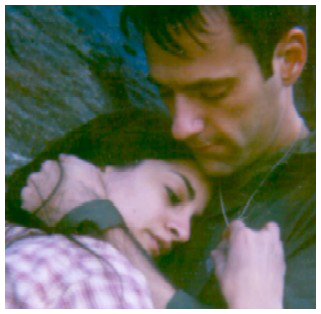Acclaimed SCREENPLAY Seeks PRODUCER
HOW HIS BRIDE CAME TO ABRAHAM
“When those who must not Love”
NY THEATRE
HOW HIS BRIDE CAME TO ABRAHAM
by Martin Denton
NEW YORK THEATRE
March 21, 2003
We begin outdoors, near the border between Israel and Lebanon in the early ’90s, where every inch of land was potentially a battlefield. In the darkness, we hear the sound of two Israeli soldiers talking, and then, an enormous explosion. One of the young men has stepped on a landmine and, we find out, has had his leg blown off. The other young man limps into view (in the middle of the audience), clearly in pain, one foot bootless and bloody. He hears a sound: from the other direction, an intruder, covered from head to toe, nears his path. His immediate assumption is that this person must be his enemy.
The stranger operates under the same assumption and tries to disarm the soldier. And though we know that we’re watching two actors performing in Praxis Theatre Project’s production of Karen Sunde’s How His Bride Came to Abraham, we are trapped with them in a landscape of fear and hatred, recreated with painstaking and heartbreaking verisimilitude by director Courtney Patrick Mitchell within the brutally intimate Looking Glass Theatre space. In such close quarters, the enmity and distrust felt by these two anonymous human beings is bald and palpable and terrible. The immediacy can’t help but move us—the first of many shattering moments in this triumphant production of Sunde’s still-timely play by one of off-off-Broadway’s best young companies.
As soon as the soldier, searching for weapons, puts his hands on his unknown assailant’s chest, he realizes that it’s a woman; abashed, he draws away long enough for her to pull free. She leads him downhill into a primitive dwelling and he warily follows. This, she tells him, is her home. She surprises him by tending his wounded foot. And so the story of Abraham—for that is our young Israeli’s name—and how his bride comes to him, begins in earnest.
Sunde’s script covers a lot of ground in a single 100 minute-long act. Abraham and Sabra (she eventually reveals her name, after much coaxing), recognize that they will need to spend the night together: his unit is engaged in battle and cannot pause to rescue him; she can’t risk navigating the heavily-mined area in darkness. Thrust together, they let their guards down, slowly. She cooks a pot of potatoes to which he contributes some tinned beef; he talks about his home and family in Jerusalem and she tells a story about a bird looking for shelter in an olive tree that turns into a dream. It doesn’t surprise us that these two young people connect on this night, despite the fact that he is an Israeli while she is Palestinian. But what does surprise us is why: they’re looking for warmth and solace, yes, but each also seeks something greater. The way of the world being what it is, neither will find it.
How His Bride Came to Abraham trades in specifics of the Israeli-Palestinian conflict, some of which are no longer up-to-date. But the broader aspects of the human condition that it illustrates—that we are so willing to blindly hate and to kill over stuff we can’t see or even define—are entirely pertinent. Eavesdropping on Abraham and Sabra as they fight and love and fight again, with the sounds of occasional shelling in the distance and a keen sense of danger outside the door of the hut where they’ve found temporary shelter, is instructive: there are people on the planet living under these conditions today and every day.
Mitchell’s staging is taut and smart, highlighting the sad and awful resonance of Sunde’s play. It’s performed on a magnificent set designed by Jenny Sawyers, lit starkly and realistically by Josh Bradford. The costumes by Janine Marie McCabe are exactly right and the sound design by Jason Atkinson, incorporating evocative music by Daryl Gregory, is splendid. Praxis has done a superb job mounting this piece.
Amir Babayoff and Maya Serhan do outstanding work as Abraham and Sabra. Babayoff conveys Abraham’s innocence (he’s just 19 years old) and his warmth and his anguish with remarkable felicity; his is an unforgettably explosive and emotional performance. Serhan gives us, in contrast, her young character’s savvy (from years lived as a refugee) and also her passion. Each lets us understand the complex and often conflicting feelings that this Israeli boy and Palestinian girl are dealing with as they negotiate this dangerous and rapturous night together.
How His Bride Came to Abraham does not offer a carefree evening of entertainment, but it does offer comfort: in a way, the timing of this engagement could not be more propitious. See it for the perspective it can provide about our current situation; see it, too, because it is superbly affecting theatre.
